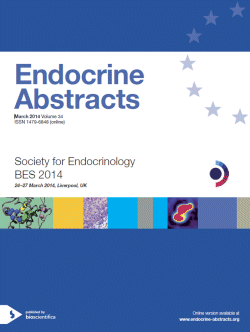Poster Presentations
Reproduction
ea0034p315 | Reproduction | SFEBES2014
Protective role of Nigerian honey on sperm indices and testis in sucrose-fed rat
Oyelowo Oluwakemi , Adekunbi Daniel , Dada Kayode
ea0034p316 | Reproduction | SFEBES2014
Effects of bovine somatotropin on libido, serum testosterone, hematology and certain biochemical metabolites of Sahiwal bulls
Dilbar Ghulam Hussain , Ahmad Nazir , Ahmad Maqbool , Ahmad Ijaz , Waqas Salman , Younis Muhammad
ea0034p317 | Reproduction | SFEBES2014
Gestational diabetes and polycystic ovary syndrome
Georgiou Christiana , Mason Helen , Bano Gul
ea0034p318 | Reproduction | SFEBES2014
Plant molecules quercetin and resveratrol can affect ovarian cells and invert FSH action
Stochmalova Aneta , Kadasi Attila , Alexa Richard , Sirotkin Alexander
ea0034p319 | Reproduction | SFEBES2014
Fetal glucocorticoid overexposure impacts on germline epigenetic reprogramming in the rat
Rose Catherine M , van den Driesche Sander , Boyle Ashley K , Chambers Thomas , Sharpe Richard M , Meehan Richard R , Drake Amanda J
ea0034p320 | Reproduction | SFEBES2014
Post-endocytic sorting of the LH receptor is mediated by a novel APPL1 dependent mechanism
Sposini Silvia , Jean-Alphonse Frederic , Newcombe Ashley , Hanyaloglu Aylin
ea0034p321 | Reproduction | SFEBES2014
Fertility and pregnancy outcomes for patients with polycystic ovary syndrome in the UK: a retrospective observational study
Morgan Christopher , Jenkins-Jones Sara , Rees Aled
ea0034p322 | Reproduction | SFEBES2014
In the mouse ovary AMH expression is independent of androgen physiology
ea0034p323 | Reproduction | SFEBES2014
Interaction of androgen with IGF signalling in preantral follicle development in the mouse ovary
Jamall Hina , Laird Mhairi , Hardy Kate , Franks Stephen
ea0034p324 | Reproduction | SFEBES2014
Regulation of implantation by interaction between the IGF receptor (IGF1R) and miR-145
Lees Miranda , Kang Youn-Jung , Forbes Karen , Aplin John
ea0034p325 | Reproduction | SFEBES2014
Renal anomalies in Kallmann syndrome, an uncommon association
ea0034p326 | Reproduction | SFEBES2014
miR-145 is associated with placental growth in mice
Jones Lisa , Charnock Jayne , Forbes Karen
ea0034p327 | Reproduction | SFEBES2014
Glial cells missing 1 transactivates the equine chorionic gonadotrophin beta promoter
Cabrera-Sharp Victoria , Read Jordan , Kitscha Phoebe , Geddis Amelie , Cartwright Judith , de Mestre Amanda
ea0034p328 | Reproduction | SFEBES2014
Hypoxia induces terminal differentiation of primary trophoblast cells in vitro
Cabrera-Sharp Victoria , Read Jordan , Mukherjee Abir , de Mestre Amanda
ea0034p329 | Reproduction | SFEBES2014
A rare cause of infertility
Imran Siddiqi Ahmed , Menon Ravi
ea0034p330 | Reproduction | SFEBES2014
Transforming growth factor-β superfamily signalling and its role in the pathogenesis of heavy menstrual bleeding
Maybin Jacqueline , Boswell Lyndsey , Duncan Colin , Critchley Hilary
ea0034p331 | Reproduction | SFEBES2014
Effect of endometrial thickness on pregnancy outcome after ICSI
Rehman Rehana , Fatima Syeda Sadia , Khan Taseer , Hussain Mehwish , Khan Rakhshaan
ea0034p332 | Reproduction | SFEBES2014
Regulation of the LH/CG receptor signalling in human endometrium
West Camilla , Hanyaloglu Aylin , Brosens Jan , Lavery Stuart , Panay Nick
ea0034p333 | Reproduction | SFEBES2014
Steroid hormones regulate cyclical expression of osteopontin and CD44 in the ovine endometrium
Tremaine Tina , Khalid Mohammed , Wathes Claire , Fouladi-Nashta Ali
ea0034p334 | Reproduction | SFEBES2014
Oestrogen implant improves symptoms of hypogonadism and lipid profile in transwomen
Kyaw Ye , Espina Maricel , Seal Leighton
ea0034p335 | Reproduction | SFEBES2014
Testosterone implant therapy: efficacy and safety in transmen and native men with hypogondism
Kyaw Ye , Espina Maricel , Seal Leighton
ea0034p336 | Reproduction | SFEBES2014
Elevation of HRPE773 (ZG16B) expression in amnion at term and in human ectocervical cell lines treated with inflammatory mediators is consistent with a function in innate immunity
Hayhurst Rachel Rachel , Hibbert Nanette , Frew Lorraine , Stock Sarah , Riley Simon , Morley Steven
ea0034p337 | Reproduction | SFEBES2014
Maternal and cord blood serum IGF1 IGF binding protein-3, in asymmetrically small for gestational age neonates
Gupta Amrit , Singh Nisha , Tiwari Swasti
ea0034p338 | Reproduction | SFEBES2014
The melanocortin system in the male reproductive axis
Dowejko Monika , Smith Caroline , Getting Stephen , Le Tissier Paul R , Murray Joanne F
ea0034p339 | Reproduction | SFEBES2014
Hyperandrogenism secondary to ovarian hyperthecosis masked by concurrent use of an aromatase inhibitor: a case report
Khan Muhammad , Ahluwalia Rupa , Shore Susannah , Waghorn Alison , Vora Jiten
ea0034p340 | Reproduction | SFEBES2014




